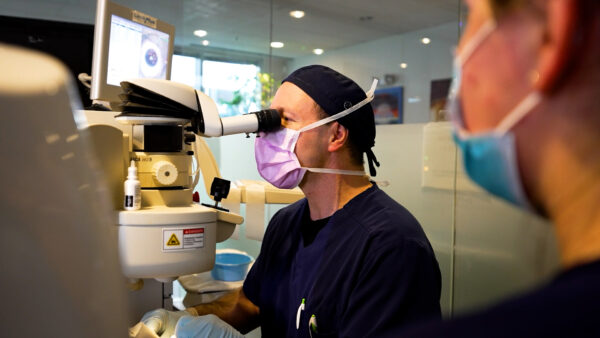Oftentimes when LASIK isn’t a good option for someone, PRK is a suitable alternative. Developed in the mid-1980s, PRK carries many of the benefits as other laser eye surgeries.
Photorefractive kerectomy (PRK) remains a common eye surgery today, especially for people who have thin or irregular corneas or who have additional conditions that reduce their candidacy for other types of LASIK vision correction.
How does PRK work?
PRK is what eye surgeons (ophthalmologists) call an “ablative” procedure. This means the surgeons ablate, or remove, tissue from the eye. (LASIK is also an ablative procedure; however, LASIK is both an ablative and incisional procedure, meaning it involves tissue removal and also tissue cutting. PRK does not involve cutting.)
PRK has two basic steps:
Step 1: Removal of outer corneal layer (called the “epithelial layers”). This will grow back.
Step 2: Laser reshaping of cornea’s middle layer (called the “stroma”). This corrects vision.
Step 1: Removal of epithelial layers
Removal of the cornea’s outer layers can happen three ways for PRK. Which way your surgeon uses will depend on his preference. The goal of any of these three ways is to expose the stroma, a middle layer of your cornea, which the laser needs to reach to correct vision.
- The surgeon can soak the outer layers with a weak alcohol solution to softens tissue, thus enabling the surgeon to remove it.
- The surgeon can remove the outer layers mechanically with a variety of surgical instruments, such as a sponge or a brush.
- Finally, the surgeon can remove the outer layers by a laser, the same one that corrects vision.
Step 2: Laser vision correction
Once the epithelial layers are removed, the surgeon can then use a laser, called an “excimer” laser, to reshape your cornea. This laser has traditionally been able to correct nearsightedness, farsightedness and astigmatism. However recent technology advancements have enabled surgeons to further customize the vision correction through WaveFront mapping, a technology found in the Hubble telescope! Custom WaveFront PRK can cost more than traditional PRK surgery, but most doctors favor customization for the added safety and the chance it will improve vision beyond what even glasses and contacts could.
How is PRK different from LASIK?
How does PRK compare with LASIK? Recall that in PRK the outer layers get removed and grow back later. In LASIK, your surgeon won’t remove the outer layers. However, instead he will create a flap in the cornea stroma. Lifting this flap provides the same service as the first step of PRK: The surgeon can now reach the stroma to perform laser vision correction.
What are the benefits of PRK?
PRK offers some benefits other eye surgeries, including LASIK, do not. A big benefit is the elimination of flap complications, since there’s no flap created. No flap equals no flap complications, in other words. PRK also leaves the eye in a stronger and more stable condition.
Finally, this is an attractive laser eye surgery for some people who aren’t good LASIK candidates. This might include people with thin or irregular corneas or who prefer not to have a flap created.
What are drawbacks of PRK?
PRK can have a slower visual recovery than LASIK. PRK might require weeks for full recovery to functional vision, for instance, whereas LASIK takes days to functional vision. During the first several days of PRK recovery, patients tend to feel varying levels of discomfort (e.g., burning and watery eyes), and they can have fluctuating vision as epithelial tissue regrows.
What results can I expect from PRK?
LASIK and PRK are surgical procedures and therefore have risks. Results from laser eye surgery vary, but most people who get laser vision correction do achieve 20/20 vision. Some do not. PRK and LASIK have been shown in clinical studies to get similar results. (Most of these studies are based on at least one year after patients’ surgery dates, because by that time, both groups of patients have achieved their full visual acuity based on their procedures.)
For more information on whether or not you’re a candidate for laser eye surgery and to learn more about risks, schedule a laser vision correction consultation.

Find a LASIK Surgery Location Near You
We’re located nationwide – it’s easy to find a LASIK Vision Center near you.
Categories:



